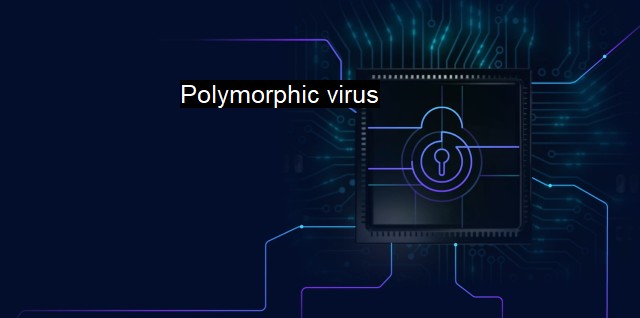What are Polymorphic virus?
The Elusive Enemy: Understanding and Confronting Polymorphic Viruses in Cybersecurity
The concept of a "polymorphic virus" in the context of cybersecurity and antivirus is an increasingly significant area of concern. A polymorphic virus is a type of computer virus that is capable of changing its underlying code without altering the basic functions or features that causes it to be identified as a threat. This means that each time the virus infects a different computer, it could potentially look like a completely new virus, and thus remain undetected by antivirus software. This makes polymorphic viruses intrinsically difficult to detect and weed out.To intuitively understand the potency of a polymorphic virus, it can be animalized as a master of disguise in the digital world, much like an octopus in the ocean that seamlessly adapts its form and color to camouflage with its surroundings, making it difficult for predators to detect its presence. From a cybersecurity perspective, the polymorphic virus uses similar tactics to evade the detection by changing its signature whenever it self-reproduces, often engendering an enormous range of mutations that can run in the millions.
This mutable nature makes them a significant concern to cybersecurity professionals. Traditional forms of computer virus defenses mainly focus on detecting known virus signatures in files and monitoring suspicious behavior. with its ever-changing DNA-like code, polymorphic viruses can penetrate such normal defenses.
Most polymorphic viruses comprise two significant parts: the encryption engine and the encrypted virus code. The encrypted virus code is where the actual malicious function of the virus sits, while the encryption engine is responsible for re-encrypting the virus code differently each instance, allowing it to smoothly bypass antivirus software.
The creation of a polymorphic virus generally involves complex coding processes employing a method known as "register renaming," where the same commands are said in different ways. For instance, 2+2=4 and 3+1=4 technically are the same but look entirely different to an antivirus software. This weak spot is exploited by the creators of polymorphic viruses by disguising the code much like the above example making its detection a formidable task.
Subsequently, identifying these malicious entities is a real challenge for common antivirus defenses due to their constant metamorphosis and adaptability. It is a strain on organizations worldwide, given the potential for extensive damage that can occur in the form of data breaches, loss of sensitive information, or disruption of systems and services.
Not all is grim as some methods can be employed to increase the chances of detecting and neutralizing these threats. Heuristic analysis is a detection method utilized in most modern antiviruses to identify unknown viruses, including polymorphs. It works by examining the entire code to map its basic structure and functions to artifacts relating to known viruses, thus broadening the scope to account for version changes. generic decryption (GD) is used to investigate polymorphic viruses. GD can execute a suspected virus in a simulated system environment while keeping vital system functionalities docked.
Even though advanced strategies such as heuristic analysis and generic decryption help combat polymorphic viruses, the ever-fluid boundaries of technologies and structural changes conceptually outline the growing fear of the potential damage that new, evolving polymorphic forms can inflict. This fact necessitates augmenting collaborations in the cybersecurity sectors to keep systems up-to-date with robust antivirus mechanisms, be more vigilant, and work on more complex, adaptive algorithms to nip this challenge in the bud.

Polymorphic virus FAQs
What is a polymorphic virus?
A polymorphic virus is a type of malware that has the ability to change its code structure or signature every time it replicates or infects a new system. This allows it to evade detection by traditional antivirus software, as the virus appears to be different each time it is encountered.How does a polymorphic virus work?
Polymorphic viruses use encryption techniques and other methods to modify their code and make it difficult for antivirus software to identify them. The virus may also contain a decryption routine that allows it to revert back to its original form once it has infected a system. This makes it challenging for security professionals to detect and remove polymorphic viruses.What kinds of damage can a polymorphic virus cause?
Polymorphic viruses can cause a range of damage, including stealing sensitive information, corrupting files, and disabling system functions. They can also spread quickly across networks and infect multiple systems, making it difficult to contain the damage. Since these viruses can evade detection, they may remain in a system undetected for extended periods of time, allowing them to cause significant harm before they are discovered.How can I protect my system from polymorphic viruses?
To protect your system from polymorphic viruses, it is important to keep your antivirus software up to date with the latest virus definitions. You should also avoid opening suspicious emails or attachments, and be cautious when downloading files from untrusted sources. Additionally, you can use intrusion detection and prevention systems to monitor network traffic and detect any unusual activity that may indicate a polymorphic virus is present. Regular backups of your data can also help ensure that you can recover your files in the event of a virus infection.| | A | | | B | | | C | | | D | | | E | | | F | | | G | | | H | | | I | | | J | | | K | | | L | | | M | |
| | N | | | O | | | P | | | Q | | | R | | | S | | | T | | | U | | | V | | | W | | | X | | | Y | | | Z | |
| | 1 | | | 2 | | | 3 | | | 4 | | | 7 | | | 8 | | |||||||